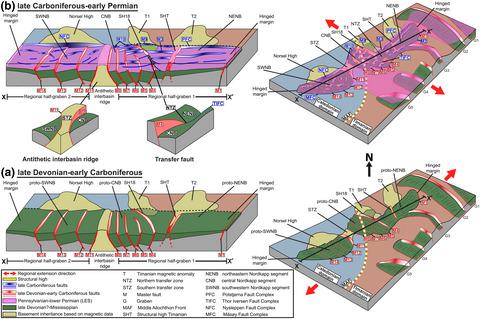当前位置:
X-MOL 学术
›
Basin Res.
›
论文详情
Our official English website, www.x-mol.net, welcomes your
feedback! (Note: you will need to create a separate account there.)
Effects of basement structures and Carboniferous basin configuration on evaporite distribution and the development of salt structures in Nordkapp Basin, Barents Sea—Part I
Basin Research ( IF 2.8 ) Pub Date : 2021-04-19 , DOI: 10.1111/bre.12565 Muhammad Hassaan 1, 2 , Jan Inge Faleide 1, 2 , Roy Helge Gabrielsen 1 , Filippos Tsikalas 1, 3
Basin Research ( IF 2.8 ) Pub Date : 2021-04-19 , DOI: 10.1111/bre.12565 Muhammad Hassaan 1, 2 , Jan Inge Faleide 1, 2 , Roy Helge Gabrielsen 1 , Filippos Tsikalas 1, 3
Affiliation

|
Potential field data, reprocessed regional 2D seismic reflection profiles and 3D seismic tied to wells were used to study the late Devonian-Permian development of the Nordkapp Basin in Barents Sea. The composite basin can be subdivided into the northeastern, central and southwestern segments that developed above a basement that contains elements of the Timanian and Caledonian regimes. The transition between the Timanian and Caledonian structures is positioned below the central basin segment. The rheological properties, locations, orientations and interaction of inherited structures together with two subsequent extensional phases, defined the presalt rift architecture and gave rise to seven subbasins within Nordkapp Basin. During the late Devonian-early Carboniferous NE-SW oriented extension, the basin consisted of two regional half-grabens (northern and southern) separated by an interbasin ridge. During the late Carboniferous, the shift of extension direction to NW-SE orientation reshaped the two regional half-grabens. In particular, an interbasin transfer zone divided the northern regional half-graben by separating its hinged-margin portion (incipient northeastern segment) from the deeper part (incipient central segment). At the same time, the elevated interbasin ridge separated the incipient central and southwestern segments. Internally within the seven subbasins, the evolving structural elements including cross-cutting master faults and structural highs have influenced the deposition and character of the Pennsylvanian-lower Permian layered evaporite sequence and the distribution of subsequent salt structures. We suggest that the synrift to early postrift processes, relative depth of each subbasin, arrangement of the structural highs and depositional palaeo-environment all controlled the thickness and facies of the layered evaporite sequence. The latter in combination with the presalt architecture comprised a laterally varying in thickness and character substratum that during the earliest Triassic influenced the sediment routings and deposition of the progradational system arriving in Nordkapp Basin. The study outcomes are pertinent and applicable to other salt-influenced rift basins worldwide.
中文翻译:

巴伦支海Nordkapp盆地基底构造和石炭纪盆地构造对蒸发岩分布和盐构造发育的影响——第一部分
潜在的现场数据、重新处理的区域 2D 地震反射剖面和与井相关的 3D 地震被用于研究巴伦支海 Nordkapp 盆地晚泥盆纪-二叠纪的发育。复合盆地可细分为东北、中部和西南段,这些段在包含蒂曼尼亚和喀里多尼亚制度元素的基底之上发展。Timanian 和 Caledonian 结构之间的过渡位于中央盆地段下方。继承结构的流变特性、位置、方向和相互作用以及两个随后的伸展阶段,定义了盐下裂谷结构,并在 Nordkapp 盆地内形成了七个子盆地。在晚泥盆世-早石炭世 NE-SW 定向伸展期间,该盆地由两个区域性半地堑(北部和南部)组成,被盆地间脊隔开。在晚石炭世,伸展方向向 NW-SE 方向的转变重塑了两个区域半地堑。特别是,盆地间转换带通过将其铰接边缘部分(初期东北段)与较深部分(初期中央段)分隔开来划分北部区域半地堑。同时,抬升的盆地间脊将初期的中段和西南段分开。在七个子盆地内部,包括横切主断层和构造高点在内的不断演变的构造要素影响了宾夕法尼亚-下二叠统层状蒸发岩层序的沉积和特征以及后续盐结构的分布。我们认为,同裂谷与早期后裂谷过程、每个子盆地的相对深度、构造高点的排列和沉积古环境都控制了层状蒸发岩层序的厚度和相。后者与盐下构造相结合,构成了厚度和特征横向变化的基底,在最早的三叠纪期间影响了到达 Nordkapp 盆地的进积系统的沉积路径和沉积。研究结果具有相关性,适用于全球其他受盐影响的裂谷盆地。后者与盐下构造相结合,构成了厚度和特征横向变化的基底,在最早的三叠纪期间影响了到达 Nordkapp 盆地的进积系统的沉积路径和沉积。研究结果具有相关性,适用于全球其他受盐影响的裂谷盆地。后者与盐下构造相结合,构成了厚度和特征横向变化的基底,在最早的三叠纪期间影响了到达 Nordkapp 盆地的进积系统的沉积路径和沉积。研究结果具有相关性,适用于全球其他受盐影响的裂谷盆地。
更新日期:2021-04-19
中文翻译:

巴伦支海Nordkapp盆地基底构造和石炭纪盆地构造对蒸发岩分布和盐构造发育的影响——第一部分
潜在的现场数据、重新处理的区域 2D 地震反射剖面和与井相关的 3D 地震被用于研究巴伦支海 Nordkapp 盆地晚泥盆纪-二叠纪的发育。复合盆地可细分为东北、中部和西南段,这些段在包含蒂曼尼亚和喀里多尼亚制度元素的基底之上发展。Timanian 和 Caledonian 结构之间的过渡位于中央盆地段下方。继承结构的流变特性、位置、方向和相互作用以及两个随后的伸展阶段,定义了盐下裂谷结构,并在 Nordkapp 盆地内形成了七个子盆地。在晚泥盆世-早石炭世 NE-SW 定向伸展期间,该盆地由两个区域性半地堑(北部和南部)组成,被盆地间脊隔开。在晚石炭世,伸展方向向 NW-SE 方向的转变重塑了两个区域半地堑。特别是,盆地间转换带通过将其铰接边缘部分(初期东北段)与较深部分(初期中央段)分隔开来划分北部区域半地堑。同时,抬升的盆地间脊将初期的中段和西南段分开。在七个子盆地内部,包括横切主断层和构造高点在内的不断演变的构造要素影响了宾夕法尼亚-下二叠统层状蒸发岩层序的沉积和特征以及后续盐结构的分布。我们认为,同裂谷与早期后裂谷过程、每个子盆地的相对深度、构造高点的排列和沉积古环境都控制了层状蒸发岩层序的厚度和相。后者与盐下构造相结合,构成了厚度和特征横向变化的基底,在最早的三叠纪期间影响了到达 Nordkapp 盆地的进积系统的沉积路径和沉积。研究结果具有相关性,适用于全球其他受盐影响的裂谷盆地。后者与盐下构造相结合,构成了厚度和特征横向变化的基底,在最早的三叠纪期间影响了到达 Nordkapp 盆地的进积系统的沉积路径和沉积。研究结果具有相关性,适用于全球其他受盐影响的裂谷盆地。后者与盐下构造相结合,构成了厚度和特征横向变化的基底,在最早的三叠纪期间影响了到达 Nordkapp 盆地的进积系统的沉积路径和沉积。研究结果具有相关性,适用于全球其他受盐影响的裂谷盆地。











































 京公网安备 11010802027423号
京公网安备 11010802027423号